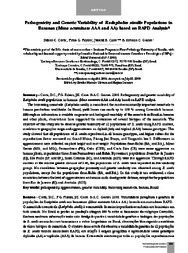Pathogenicity and genetic variability of Radopholus similis populations in bananas (Musa acuminata AAA and AA) based on RAPD analysis.
Pathogenicity and genetic variability of Radopholus similis populations in bananas (Musa acuminata AAA and AA) based on RAPD analysis.
Author(s): COSTA, D. da C.; FALEIRO, F. G.; CARES, J. E.; GOMES, A. C.
Summary: The burrowing nematode (Radopbolus similis) is considered the most economically important nematode to banana production worldwide. In Brazil, yield losses can reach up to 100 % among Cavendish bananas. Although no information is available on genetic and biological variability of the nematode in Brazil in bananas and other plants, observations have suggested the occurrence of several biotypes of the nematode. The objective of this study was to observe genetic variability of 12 populations of R similis using RAPD markers, in relation to geographic origin and aggressiveness on diploid (AA) and triploid (AAA) banana genotypes. This study showed that all populations of R similis reproduced in all banana genotypes, and higher values for the reproduction factor occurred on Grand Naine, Pisang Jari Buaya, and Yangambi km 5. Differences in aggressiveness were reflected on plant height and root weight. Populations from Bahia (BA1 and BA2), Minas Gerais (MG1 and MG2), Pernambuco (PE), Cuba (CUB), and Costa Rica (CR) were more aggressive on banana plants, in particular those from Pernambuco and Bahia. By contrast, populations from Rio de Janeiro (RJ), São Paulo (SP1 and SP2), Santa Catarina (SC), and Australia (AUS) were less aggressive. Through RAPD markers at the relative genetic distance of 0.45, the populations of R similis were separated in five similarity groups. No correlation between geographic proximity and genetic similarity was observed among R similis populations, except for the populations from Bahia (BA1 and BA2). In this study it was evidenced a close association between the level of aggressiveness on bananas and a short genetic distance, except for the populations from Rio de Janeiro (RJ) and Australia (AUS).
Publication year: 2008
Types of publication: Journal article
Keywords: Banana, Brasil, Musa acuminata, Nematóide, Patogenicidade, Radopholus similis, Variedade genética
Observation
Some of Embrapa's publications are published as ePub files. To read them, use or download one of the following free software options to your computer or mobile device. Android: Google Play Books; IOS: iBooks; Windows and Linux: Calibre.
Access other publications
Access the Agricultural Research Database (BDPA) to consult Embrapa's full library collection and records.
Visit Embrapa Bookstore to purchase books and other publications sold by Embrapa.

